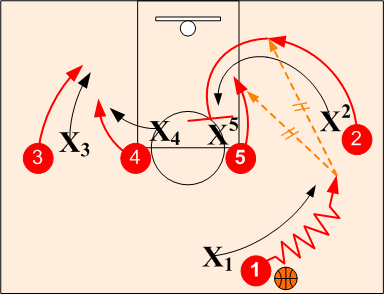- Offensive Techniques & Strategies
Ten Principles of a Sound Offense

For a set offense to be sound, it must be designed to not only accomplish the primary objective of creating a good shot, but also to achieve the following important principles:
It must be simple with the emphasis on execution and fundamentals.
It must keep all defensive players occupied.
It must provide for strong offensive rebounding position.
It must allow for defensive balance.
It must provide for proper floor space (15').
It must make all five players a scoring threat.
It must move smoothly from one option to another.
It must be adjustable to different levels of speed.
It must have counter options to take advantage of defensive overplays and traps.
It must be flexible to meet various types of defensive pressure.

Things to Remember About Offense
Winning basketball is a team effort with all five teammates receiving help from one another.
Offensive fundamentals must be mastered before any offense can be run. A play, no matter how good, will never be successful unless it is executed properly.
Move the ball with sharp, accurate passing. Pass to the open man. You will be surprised how many times that’s you.
Get open for shots before you receive the ball. Work for the ball, do not stand and call for it.
Meet all passes assuming a triple threat stance (shot, drive, & pass) upon receiving it.
When over-played by a defender, back cut to the basket and shoot over any defender that sags off.
Avoid the trap or one bounce dribble. Always stop your dribble with a shot or pass.
Never dribble when it is possible to pass. Too much dribbling ruins team play.
Develop pride in your passing and work hard to perfect all types of passes.
Take good shots. Make sure no teammate is open for a better shot.
Assume every shot will be missed and rebound. Getting second and third efforts are imperative.
Without the ball, move with a purpose. Each movement should result in a screen, pass reception, rebounding position, or a good shot.
Free throw shooting is a repetitive, neuromuscular skill, the more you practice, the more accurate you will become.
Use the change of pace and direction effectively to get open. Make sharp cuts and avoid moving in arcs.
Acknowledge and compliment every assist, save, clutch rebound or other valuable play by a teammate.
Back cut to the basket or clear out when a teammate dribbles towards you.
Posting up is not limited to just big players, look for all teams to exploit size mismatches at any position. On mismatches is much better to take your defender inside than to go one on one outside.
It is better to be a second late than a second early on offense.
Always know how much time and how many time outs are left in a game.
Bill Russell, one of the most dominant players ever to play the game, is a reminder how great you can <?php include '../../../footer/footer.php' ?> become without being a high scorer.
Return to Practice Guidelines - Click Here
Return to Coaching Strategies - Click Here
Return to HoopTactics - Click Here
© 2026 HoopTactics All Rights Reserved.
